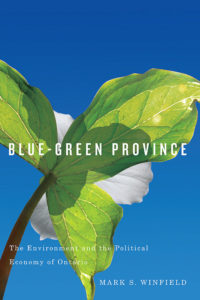Environmental Policy and Politics in Ontario

Blue-Green Province: The Environment and the Political Economy of Ontario
Mark Winfield - UBC Press, 2012
Blue-Green Province provides the first comprehensive study of environmental policy in Ontario and explores what lessons on the future of environmental and economica policy in Canada might be learned from this province's experience.
Download the open access version here.
Environmental Policy in Ontario: ‘Greening’ the Province from the ‘Dynasty’ to Wynne
Mark S. Winfield, Ph.D | August 2015
Final version published as Winfield, M., "Environmental Policy in Ontario: ‘Greening’ the province from the dynasty to Wynne" in J.Malloy and C.Collier, The Politics of Ontario, 6th Edition (Toronto: University of Toronto Press, 2017).
Phasing-Out Coal-Fired Electricity in Ontario - Chapter 19
Mark Winfield and Abdeali Saherwala | January 2021
Working Paper for Policy Success in Canada (Oxford, 2022)
The phase-out of coal-fired electricity production in the Canadian Province of Ontario has been widely described as one of the most significant measures taken by any government in the world to reduce greenhouse gas (GHG) emissions. The phase-out of coal, which in the early 2000s constituted a quarter of the province’s electricity supply, was completed in 2014. The phase-out was associated with dramatic improvements in air quality in southern part of province. As such, it is regarded as a core environmental legacy of the 2003-2018 Liberal governments of Premiers Dalton McGuinty and Kathleen Wynne.
Although an undeniable success in terms of emissions of GHGs, smog and acid rain precursors, and heavy metals, like mercury, the province’s approach to the phase-out did involve significant trade-offs in terms of the environmental and economic sustainability of the province’s electricity system. The phase-out was associated with a substantial re-expansion of the role of nuclear energy in the system, and the period over which the phase-out took place characterized by major increases in electricity costs for residential consumers. The phase-out was also a product of a wider politicization of decision-making around the system, the consequences of which continue to affect the province’s politics profoundly.
This paper explores the evolution of the role of coal-fired electricity in Ontario, the environmental, health and political drivers of the concept of a coal-fired electricity phase-out, and the processes through which the phase-out was completed. The paper examines the environmental health benefits and trade-offs associated with the phase-out, as well as the impacts of the phase-out on electricity costs, and the configuration of the province’s electricity system, including the rise and demise of the 2009 Green Energy and Green Economy Act. The paper assesses the impact of the phase-out process on the province’s overall all approach to decision-making around the electricity system, and the long-term political impacts of the phase-out.
Ontario and a Changing Climate
M. Winfield and C. Kaiser | April 2020
Working Paper for Ontario Since Confederation
This paper examines the impacts of climate change on Ontario, and the evolution of climate change policy in Ontario from the late 1980s to the present day. The paper highlights the specific challenges of GHG emission reductions in the province, particularly in areas like buildings and transportation, that are difficult to address through carbon pricing strategies alone.

